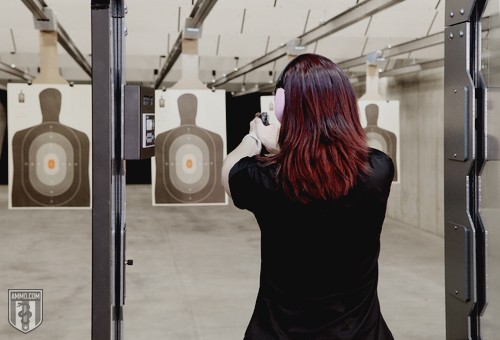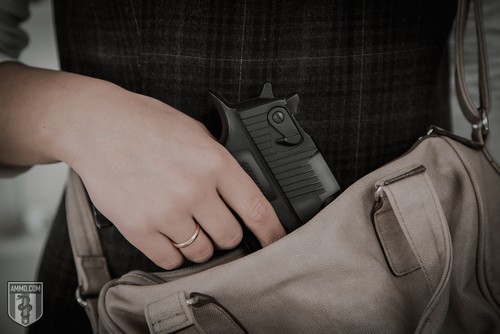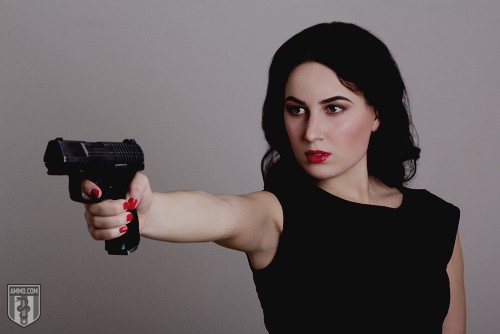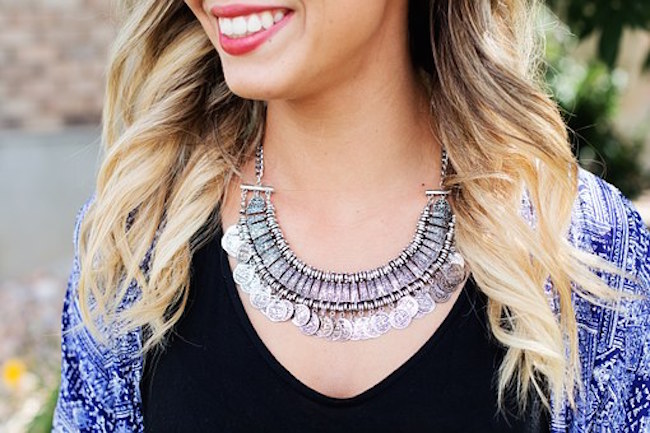Arming Yourself: A Woman’s Self-Defense Guide to Concealed Carry (CCW) from Ammo.com
A stark difference from 20 years ago, women across the country are owning guns and participating in target shooting and hunting more than at any time in the past. According to a 2015 survey by the National Sports Shooting Foundation (NSSF), more than one-third of women gun owners identified as new to gun ownership. The report also shows some major increases between 2004 and 2011 – including a 77-percent increase in women who own firearms, a 36-percent increase in women who target shoot, and a 23-percent increase in women who hunt.
Yet, even with more women engaging in shooting sports, that’s still not the reason so many are purchasing guns. It’s not for hunting. It’s not for fun. It’s for self defense. A 2017 Pew Research Center survey reported that women are more likely than men to cite protection over recreation as a major reason for owning a gun. What’s more, 27 percent of women gun owners cite self defense as their only reason, compared to only eight percent of male gun owners.
Now more than ever, women are buying guns to protect themselves. They work long hours and walk home alone at night on city streets. Women live alone in apartments, suburban homes, and country farms – and they do it independently of men. 50 years ago, self and home protection typically fell to the man in the household, but that’s not the case today. The modern woman is stepping up her role to protect herself and the people she cares about.
How to Buy Your First Concealed Carry Handgun
When it comes to finding a firearm to use for self-protection, the right gun can literally be a lifesaver. It’s not a decision you should take lightly, and you can’t just rush into the gun store to buy the first one recommended.
The most important thing when purchasing a weapon to carry concealed is getting the right size firearm. You want a weapon with enough stopping power to protect you, but one that’s easily controlled – even in a high-stress situation.
Size and Weight
For concealed carry, most people opt for a smaller handgun. They’re easy to hide and less cumbersome while going about your business. Yet when it comes to self-protection, you don’t want a tiny, low-caliber firearm. For the ultimate stopping force in a self-defense situation, choose something with at least a .38 caliber, and opt for it in a smaller design.
By choosing a smaller design, it’s easier for you to remove from the holster and harder for attackers to grab. These smaller caliber guns are easier to control, have less recoil, and don’t need nearly the hand strength as larger handguns. But the smaller and lighter the gun, the more practice and training you’ll need – as these guns require more accuracy to take down an attacker.
Make sure the gun you choose fits your hand. This lessens the perceived recoil and makes the gun easier to shoot. If the gun’s easy to shoot, chances are you’ll be shooting more often. And the more often you shoot, the better and more comfortable you’ll be with the gun. It’s a win-win situation.
Revolver or Semi-Automatic
Choosing the right handgun depends on the woman and what her needs are. Both revolvers and semi-automatic pistols come in sizes and calibers that can safely be used for self-defense, and neither is necessarily better than the other.
In general, revolvers tend to be simpler and are therefore less likely to have something go wrong during an encounter. The mechanisms are rather basic, the guns are easy to clean, and even if not cleaned meticulously after use, they still shoot straight and true when you need them to.
If you’re looking at a revolver for self-protection, consider a .38 Special. It packs enough stopping power, yet can be found in a small enough size that the recoil is minimal. Another thing to consider is that revolvers don’t offer the same trigger safety switches that semi-automatics do. But because the hammer must be cocked, it’s a tighter squeeze and not likely to misfire.
That doesn’t mean semi-automatic pistols aren’t the way to go. These guns tend to be smaller, lighter, and slimmer, making them easier to wear and conceal than revolvers. Semi-automatics also hold more ammunition, shoot more rapidly, and are easier to reload – especially when using a clip or magazine. They also have trigger safety switches that must be flipped before the firearm ignites. Top self-defense calibers for women include .380, 9mm, .40 S&W, and .45 ACP.
Other Considerations
- Make sure you get a gun that’s easy to use under stress. It needs to be easy to load and easy to pull the trigger mechanism. If your gun has a habit of locking or sticking, it’s fine for the range, but not for self-protection.
- Consider a handgun with a laser sight. There’s something to be said about seeing a red dot on an attacker’s chest that boosts your confidence. You can also add spot lights to different styles of guns, allowing you to see during a night attack.
- You can opt for a handgun with a long trigger pull if you’re worried about firing before you’re ready. Because it requires a deliberate and strong pull to fire, you won’t accidently shoot before you’re ready – regardless of how much adrenaline is pumping through your veins.
Try Them Out
Many gun shops and ranges allow you to rent guns to shoot. Before you decide on a firearm to purchase, take advantage of this opportunity. Spend an afternoon target shooting, trying as many different handguns as you can. Nothing will tell you more about how a gun handles than shooting it.
Remember, while recommendations are appreciated, and should maybe even be sought out, take them for what they are: recommendations. No one can pick the right gun for you, just like no one can pick a great pair of shoes. Only you know how it fits in your hand. Only you know how it feels to pull the trigger. Only you can determine what handgun is the one that’s going to make you feel safe and comfortable carrying it concealed.
Learning About Guns and Self Protection

Wits a rise in women carrying concealed, it is important to understand your weapon and to feel comfortable with it in your hand. And the best, as well as the quickest, way for this to happen is by taking a class or course on guns.
Gun Classes
There are classes available for new gun owners and refresher courses for those who haven’t shot in a while. Classes can be about a variety of gun topics – including handguns, rifles, shotguns, self-defense, and carrying concealed, as well as those specifically for women. No matter what your gun shooting experience and knowledge, there’s bound to be a local class that can teach you something. Ask at the shooting range, game commission, or gun club. Or call your state representative to inquire about what’s available in your area.
If you’re unsure if a class is right for you, consider these things. Classes teach you everything you need to know about your gun, and perhaps most importantly, they demystify firearms for those who’ve never been around guns. They teach you how to take them apart and put them back together. They teach you how clean them, how to handle them, and how to shoot them. They teach you about gun safety and the legalities of carrying concealed in your area. The courses often have drills to get you used to pulling and drawing your firearm, building your confidence and comfort levels. And most of these courses are a blast. You’ll break targets, shoot at balloons, and have more fun than you ever thought possible with a gun in your hand.
Also crucial, these courses teach you the right way to handle a gun. It doesn’t matter if gun owners are veterans, police officers, or hunters – people have bad habits when it comes to guns, and they often don’t know it. By learning from the pros, you’ll be learning the right way and avoiding the bad practices of others.
Head to the Range
Regardless if you’re a newbie or a seasoned pro, practicing regularly is key for the ability to handle your gun effectively and consistently. And the best way to get your practice is to head to the range. Many shooting ranges offer both indoor and outdoor shooting areas, and some have events, clubs, and competitions. Consider joining one and spending a few days a month there. That way, if the time comes when you need to use your weapon, you know you can do it without second guessing yourself.
If you have a few different guns available to use, consider starting off with a smaller caliber. Because these require less of a handgrip and have a lower recoil, you can focus more on learning gun skills and proper shooting technique instead of fighting the gun’s kick and trying to keep it under control.
Carrying Concealed Fashion

When it comes to carrying concealed, things are a little more difficult for women. Their clothing tends to be more form fitting and more revealing. And when you’re packing a firearm, you must be aware of where you’re carrying it and if it’s staying concealed.
Luckily, women have a range of options. Your weapon can be worn on the hip, under the arm, in the bra, around the belly, between your legs, at your thigh, or even at the ankle. While some of those sound uncomfortable, most holsters are designed for comfortability as well as function.
Here’s the breakdown of how most women choose to carry concealed:
- 40% at the waist/hips, inside the pants
- 15% in a belly band wrap
- 13% in a concealed carry purse
- 10% on the waist, outside the pants
- 8% in a bra holster
- 7% in an underarm/shoulder holster
- 5% in a deep concealment pouch
- 1% on the thigh
- 1% at the ankle
With all these different body parts to choose from, how are you supposed to know which is best? Well, that depends on your preferences, the type of gun you’re carrying, and how quick you can maneuver your piece out of the holster and into your hand.
Carrying on the body is always best, and the waist/hip area tends to be the most efficient. You know it’s secure, it’s easy manage, and it’s quick to draw – but this isn’t always a possibility. When that’s the case, here are a few tips for carrying concealed while keeping fashion in mind:
- A bra holster gives you a hidden shelf to conceal your weapon. While the idea may not seem comfortable, it hides the gun, no matter what you’re wearing.
- Thigh holsters are a great option when you’re wearing a dress, especially if it’s form fitting. It can be positioned so that it’s not visible on the contour of your body, but still allows you to carry.
- When you can, wear clothing that’s long and loose. It hides bulges and makes you feel more comfortable while carrying concealed.
- Think about a holster that doesn’t rely on a waistband to stay in place. Many summer shorts and skirts do not have a tight enough band to hold a firearm, and you’ll constantly be struggling to keep it in place.
Concealed Carry Purses
While it’s never recommended to just throw your weapon in a purse, there are specially designed bags for women who want to carry concealed. These purses have a specialized external pocket, perfect for you to reach in and pull out the firearm.
It’s necessary to remember that carrying your weapon in a bag puts you at a higher risk, as does any time when your gun isn’t physically on your body. There’s the chance of someone getting their hands on your purse, which means they have your gun too.
You also have to maneuver the handgun out of your bag, wasting precious time in an encounter. There may be a situation when there isn’t enough time to remove the gun, aim, and shoot. Instead of wrestling the gun out, shoot through the bag. Before purchasing, make sure there’s enough room for the bullet casings to eject to avoid jamming, or use a revolver when carrying in a purse.
Tips for Shooting and Self Protection
Here are the basics of what you need to know about shooting and self-defense:
Stance
 Any time you’re shooting, your stance is important. But when you’re shooting in self-defense, stance is vital. With the right stance, you improve accuracy and speed, all while staying as safe as possible.
Any time you’re shooting, your stance is important. But when you’re shooting in self-defense, stance is vital. With the right stance, you improve accuracy and speed, all while staying as safe as possible.
The first lesson in stance is to lean in, not back. By keeping your weight forward, with your head in front of your shoulders and your shoulders in front of your hips, you’re more stable and less likely to be jolted off balance by a gun’s recoil.
Second, your knees should be slightly bent and never locked. This, too, helps with your balance and stability – as well as ensures that you stay mobile, easily moving in any direction, which is essential in any attacker situation.
Here are some self-defense stances to start practicing:
The Isosceles Stance: Named for the type of triangle your arms make, the isosceles stance involves standing with your feet shoulder-width apart with both hands on your handgun, arms straight out in front of you. It’s how most people practice shooting, although you’ll rarely have the opportunity to utilize it in a real-life attacker situation. But that doesn’t mean it’s not useful. This stance gets you familiar with your firearm and allows you to become more comfortable shooting it.
The Weaver Stance: A more realistic approach, the weaver stance still uses two hands, but the body is turned to the side, making you less of a target. With a shoulder toward the attacker, both elbows are slightly bent. In this stance, it’s easier to pivot, rotate your arms, and move out of the way quickly. If you’re using this stance and your arms are trembling with adrenaline, straighten them to stabilize the shot.
The Bullseye Stance: Although you should always shoot with both hands, sometimes that’s not a possibility. You may be restrained or injured or who knows what, so it’s best to learn how to shoot single-handed, with both your dominant and nondominant hand. Stand to the side, with your arm straight out, in line with your body. While your gun stabilization is not as strong in this stance, it does make you a smaller target and needs to be practiced.
Grip
The most important thing when gripping your handgun is to think of it as an extension of your arm. From pulling it out of the holster, to drawing it up and taking aim, the whole motion should be fluid and smooth. Your hand should be tight and strong, and there should never be a break at the wrist. If your grip is limp, the firearm’s recoil will be stronger, making it difficult to control, and taking longer to prepare for a second shot.
To make your grip as strong as possible, hold the firearm as high on the backstrap as you can. If the gun fits you well, your whole hand should wrap around it. If you can, wrap your thumb over your fingers and squeeze. This makes your hold stronger and gives you more control, plus makes it harder for an attacker to get the handgun away from you.
When using a two-hand grip, which you should if it’s possible, wrap your non-dominant hand around the other hand for support, with your dominant thumb underneath your other thumb. This gives you extra control, while keeping your hand out of the way of the slide and bullet ejection.
Whatever happens, remember to hold onto your gun like your life depends on it. Because it very well may.
Drills
Drills are not only important, but they’re completely necessary if you want to be skilled with your gun. Yet it’s important to remember that no amount of practice will truly prepare you for a lethal encounter.
When you first start shooting your gun, you may want to do intense self-defense drills where you’re dressed in camo and shooting at pop-up terrorists hiding behind tankers – but that’s not what you should be doing. Instead, start at the beginning, where you learn the basics and learn them well. Without mastering the basic skills, more advanced techniques are not a possibility.
When doing drills, vary them as much as possible and try to make them realistic. Do dry runs at home, in your car, and at the range. Do them standing, sitting, and from the ground. Use both hands, your left hand and your right. Wear your gun in different places and in different holsters. Imagine what it would be like when you’re attacked from behind and do drills based on an assailant getting you to the ground. Run through every imaginable situation and prepare for it.
When you can, practice with 3D targets. If you can dress them in clothing, even better. While it may sound silly, shooting at things that look more human than a flat piece of paper allows your drills to be more realistic.
Practice force on force. Shooting at the range is one thing – so is shooting from a straight stance at a non-moving target. But if you really want to practice and be prepared, you must practice force on force. One of the best ways to accomplish this is through dry runs, using your gun without any ammunition and with a trained professional, or at a paintball course with a paintball gun.
A Few Last Tips about Guns and Self-Defense
- It’s always more important to not get shot than it is to shoot the bad guy.
- If you’re going to get your permit to carry concealed, do it as often as you can. You never know when an attack may happen, and you always want to be prepared.
- When you can, get loud. Better yet, run.
- Never let an assailant get within arm’s reach. If he asks for your purse, throw it to him. And never, for any reason, let him take you somewhere. Fight like you’re fighting for your life, because you probably are.
- Remember, the best self-defense is awareness, so pay attention. When you’re walking, put down your phone and take out your earbuds. Pay attention to those around you and don’t put yourself in high-risk situations.
If you’re a woman interested in concealed carry for self-defense, it’s just as important to be educated as it is to be prepared. That’s why you need to know what type of firearm you should be carrying, how to take care of it, and how to shoot it – but it doesn’t stop there. You also need to know how to wear it, conceal it, and defend yourself with it.
Be educated. Be prepared. And when the time comes that you need to protect yourself, you’ll be more than ready.




